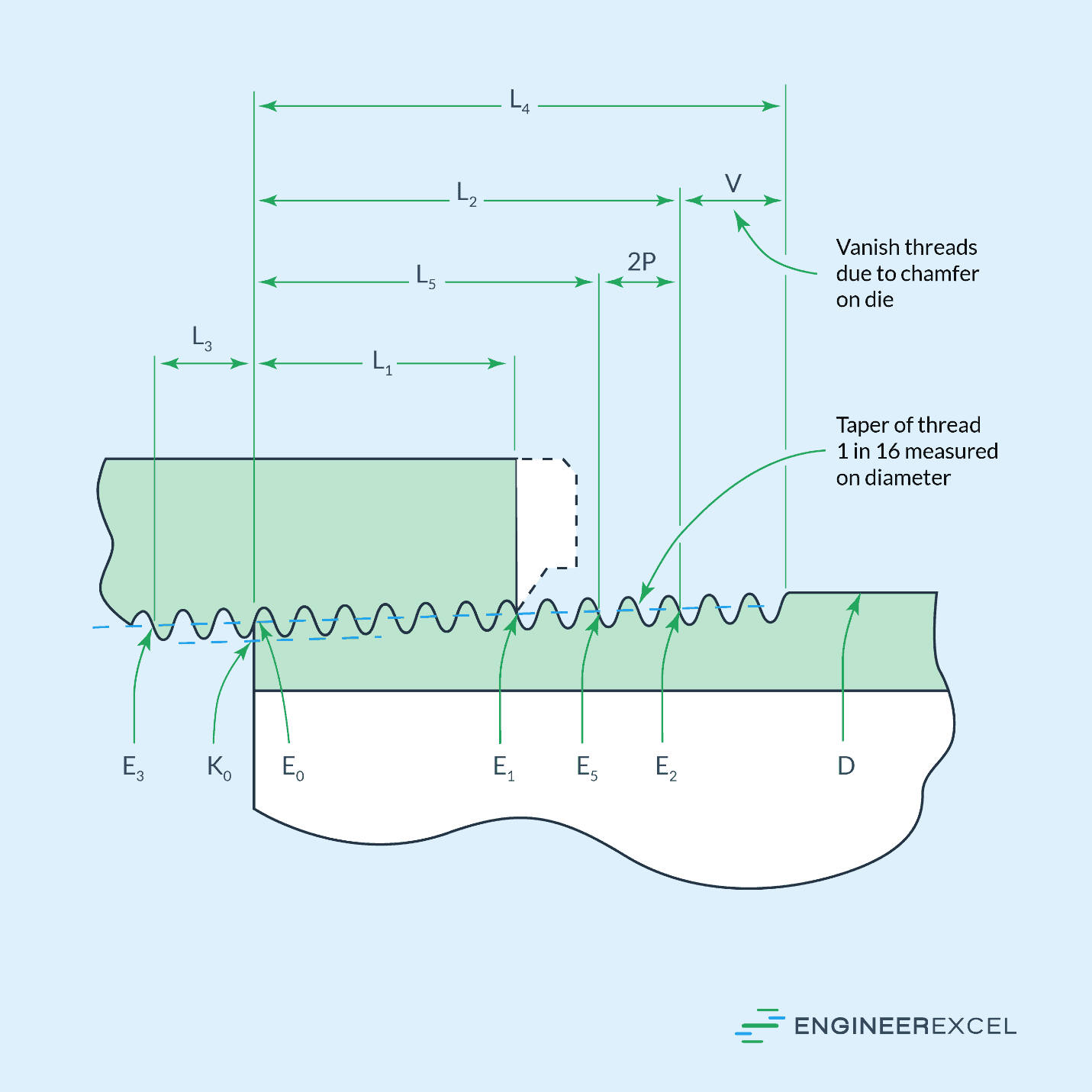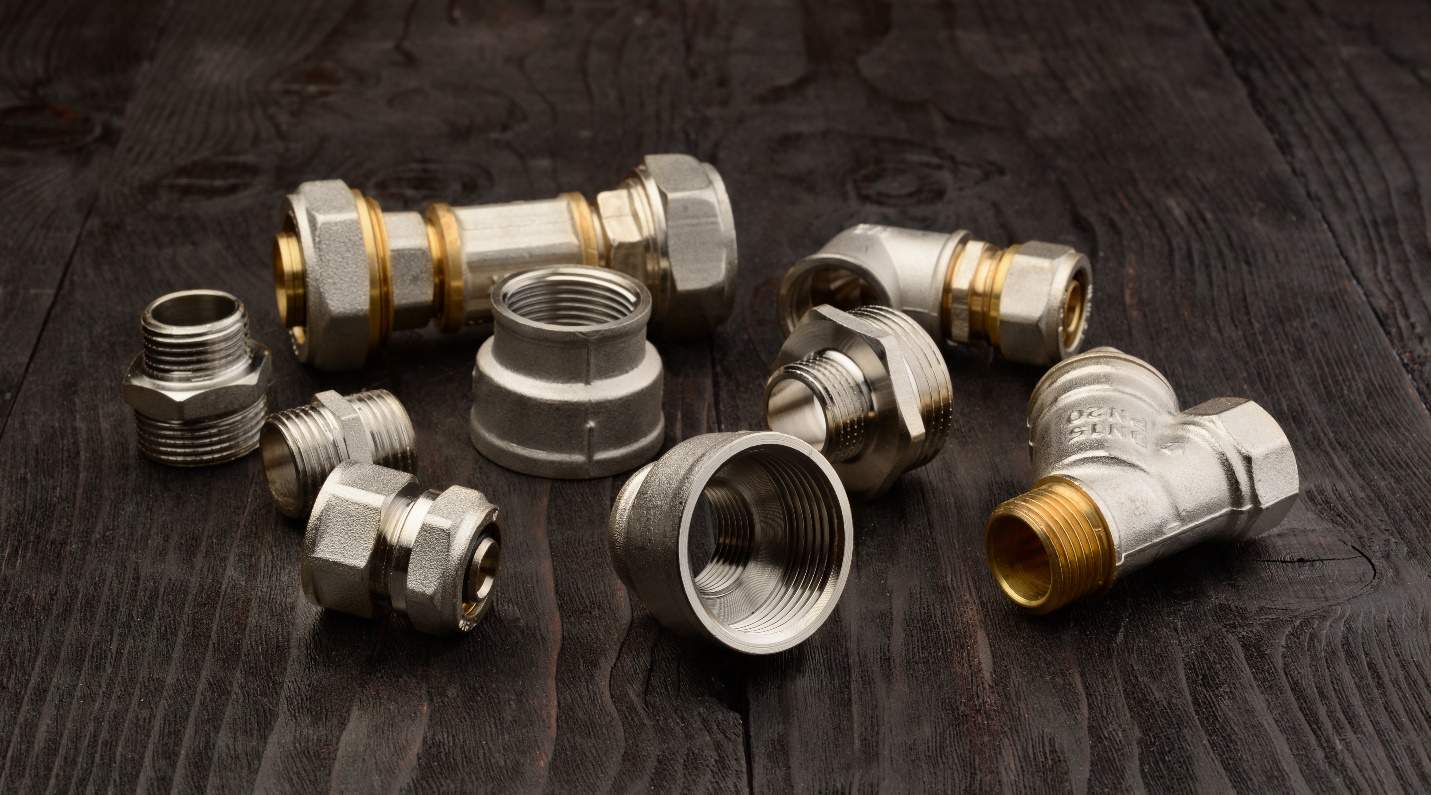Manufacturers worldwide follow thread standards when manufacturing threaded components such as screws, nuts, bolts, pipes, and fittings. One such standard is the American National Standard Pipe Thread, more commonly called the National Pipe Thread (NPT)— a national technical standard for screw threads used on threaded pipes and fittings particularly in North America.

NPT Thread Dimensions
An NPT thread follows a symmetrical V-shaped form with a thread angle of 60° and a flank angle of 30°. As shown in the figure below, this creates an imaginary sharp triangular form with a full height dependent on the thread pitch equal to:

Where:

Elevate Your Engineering With Excel
Advance in Excel with engineering-focused training that equips you with the skills to streamline projects and accelerate your career.
- H = full height of the V-shaped form [in]
- P = pitch of the thread [in]

However, the crests and roots of the thread are truncated, reducing its depth down to a maximum height equal to:

Where:
- h = maximum truncated height of the thread [in]
The orientation of the truncation may be done parallel to either the pitch line or the axis. Furthermore, it may be truncated either linearly such that it creates sharp corners, or in radius form such that it creates rounded corners.
The allowable height range of the thread for different pitch values are tabulated below:
The National Pipe Thread is formally defined in ANSI/ ASME 81.20.1 for its inch version and in ASME 61.20.2M-2005 its metric translation.
Types of NPT Threads
The National Pipe Thread system is a widely used standard with several variations that have been developed to meet the diverse needs of different piping applications. These variations are divided into five main thread series including the National Pipe Taper (NPT), National Pipe Straight Coupling (NPSC), National Pipe Taper Railing (NPTR), National Pipe Straight Mechanical (NPSM), and National Pipe Straight Locknut (NPSL).
National Pipe Taper (NPT)
In general, the NPT acronym refers to the National Pipe Taper— the most commonly utilized series under the National Pipe Thread system. It is widely used in applications where pressure or fluid flow is involved, such as in pipelines, hydraulic systems, steam systems, as well as in gas and oil industry applications.
NPT consists of both internal and external taper threads that are intended to be wrenched with a sealant to create a pressure-tight joint. These threads have a taper of 1 inch per 16 inches of length— meaning that the diameter measured diametrically relative to the axis decreases by 1/16 inch for every inch of length.

NPT threads come in various nominal pipe sizes ranging from 1/16 to 24 inches. Take note that the nominal pipe size is roughly related to the inside diameter of the Schedule 40 pipe series and not to any of the actual diameters of the NPT threads, which are typically larger than the nominal pipe size.
The different NPT sizes and their dimensions are listed in the table below:
These dimensional parameters are graphically shown in the following figure:

When preparing holes for tapping, it is crucial to cut the minor diameter of the thread using the tap minor diameter to ensure that the resulting thread is concentric with the pitch diameter and has the appropriate thread height and truncations. The hole can either be straight or tapered and should be approximately equal to the basic minor diameter at the small end of the pipe, as shown in the last column on the table above.
National Pipe Straight Coupling (NPSC)
NPSC refers to internal straight or parallel threads that can be used to mate with NPT external taper threads to form pressure-tight joints when tightly wrenched with sealant. They come in various nominal pipe sizes ranging from 1/8 to 4 inches.
The different NSPC sizes and their dimensions are listed in the table below:
National Pipe Taper Railing (NPTR)
NPTR consists of external and internal taper threads used to create rigid mechanical taper thread joints for railings, such as in handrails and guardrails. Its form is closely similar to NPT, however, the length of the external thread has been reduced to allow the use of the larger end of the pipe thread, while the internal thread has been recessed to provide coverage for the last scratch or sharp edges of incomplete threads on the pipe. They come in various nominal pipe sizes ranging from ½ to 4 inches.
The different NPTR sizes and their dimensions are listed in the table below:
National Pipe Straight Mechanical (NPSM)
NPSM consists of internal and external straight pipe threads used to create free-fitting mechanical joints for fixtures. It is often utilized in non-pressurized applications with no sealing requirements and in mechanical assemblies requiring straight thread joints. They come in various nominal pipe sizes ranging from 1/8 to 6 inches.
The different NPSM sizes and their dimensions are listed in the table below:
National Pipe Straight Locknut (NPSL)
NPSL consists of internal and external straight pipe threads used to create loose-fitting mechanical joints with locknuts. Its design aims to create a pipe thread with the maximum possible diameter that can be cut on standard pipes.
Normally, internal and external NPSL threads are made to mate with each other. However, an NPSL thread may also be mated with a taper thread in some cases. NPSL threads come in various nominal pipe sizes ranging from 1/8 to 12 inches.
The different NPSL sizes and their dimensions are listed in the table below:
NPT Pipe Size Measurement
The nominal pipe sizes of NPT threads do not refer to any of their actual diametrical measurements. To determine the nominal pipe size of a thread, a caliper is normally used to obtain an approximate measurement of its diameter and use this value to identify its size based on published NPT thread dimensions.
For a male (external) thread, the outside diameter across the bottom end is normally used. For a female (internal) thread, the internal diameter across the top opening is used.

The actual diameter measured is then cross-referenced against published approximate diametrical values like the one shown in the table below:
For example, a male NPT thread with a measured outside diameter close to 0.840 inches would be identified as a ½-inch NPT.
NPT Thread Designation
NPT threads can be specified using the following format:
Nominal Pipe Size + Number of Threads per Inch + Thread Series Symbol
The nominal pipe size may be in fractional or decimal form. Furthermore, threads are assumed to be right-handed unless otherwise specified by appending LH at the end of the designation.
For example:
- “¾-14 NPT” specifies a National Pipe Taper thread with a nominal pipe size of ¾ and a pitch of 14 threads per inch.
- “½-14 NPSM LH” specifies a left-handed National Pipe Straight Mechanical thread with a nominal pipe size of ½ and a pitch of 14 threads per inch.
Applications of NPT Threads
NPT threads are used closely the same way as BSP threads, except that they are only predominantly used in North America. The tapered form of NPT allows the threads to be pulled tightly together, creating a seal that is resistant to vibration, shock, and any type of leakage.

The most common use of NPT threads is to connect pipes, valves, and other fittings in plumbing systems. They are also commonly used in gas lines, compressed air systems, hydraulic systems, and pneumatic systems, where a secure and tight seal is essential.
